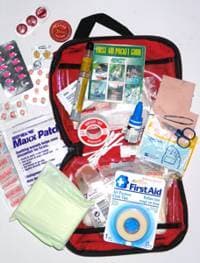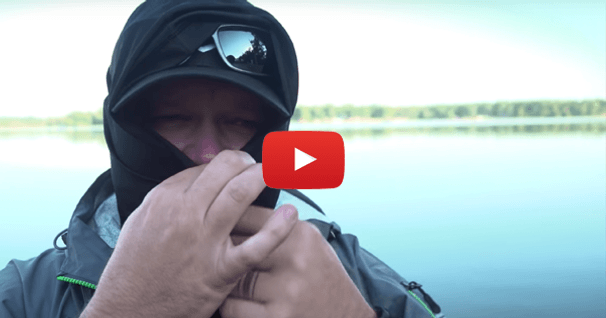First-aid Kits & Allergic Reactions
My wife and I were portaging in the far north when our dog, Bailey, disturbed a nest of wasps and brought them directly back to us. Alana was stung three times. I was stung twice. And Bailey had a total of five nasty stings, all on the tip of her nose. None of us had ever been stung before and I was quite concerned we would suffer the severe affects of an allergic reaction. Luckily the stings just hurt a lot and Bailey's nose became slightly swollen.
Now we just had to worry about getting stung again, since the more you get stung the more chance you have of having a reaction. But what's the chance of being stung again - right? How about the next portage? Bailey disturbed yet another nest and we all got covered in welts. We were lucky. A few tablets of Benadryl and we were fine.
What's an allergic reaction? Allergens are the toxins that create allergic reactions and are introduced to the body by injection (wasp sting), ingestion (swallowing peanuts), or absorption (touching poison ivy). Your body will try to fight off the allergens by using antibodies. The problem is, however, some toxins will make your body produce the wrong antibodies and you fall prey to your own defense system, which is called an allergic reaction.
Anaphylactic Shock The most troublesome reaction to have in a remote area is an anaphylactic shock. This can become fatal in a matter of minutes. The reaction is affecting the entire body, especially the respiratory system, and if left untreated it may soon lead to respiratory failure.
The first step in treating anaphylactic shock is to first know how to recognize it. Things get risky when the entire body is being affected by the allergic reaction. Pain from a wasp sting or even slight swelling isn't an issue. When a rash and/or swelling happen in areas other than where you got stung, then you've got problems. The reaction usually occurs between 5 - 15 minutes after being exposed to the allergy and if the patient shows any sign of difficulty in breathing you must act fast and administer a drug called epinephrine. This is a prescription drug that must be injected by way of an Epi-pen. It's not difficult but you must be trained by a physician prior to using it. Improper use of epinephrine can be dangerous. And once you have given the patient epinephrine you must also follow up with a dose of Benadryl.
Pain relief for stings Bees and wasps inject venom under the skin by using a stinger. The bee's stinger is barbed, like a fish hook, and remains in your skin, where the wasp stinger is smooth and can be used numerous times. They both really hurt, producing a burning sensation, followed by redness of the area and possible swelling. Here are a few things you can do to relieve the pain:
- Remove the bee sting with a scraping motion of the fingernail.
- Wash area with soap and water.
- Wash with antiseptic.
- Place a cold compress or calamine lotion to the area (baking soda or even mud is a good substitute).
- Rub an Aspirin tablet on the sting area.
Being Prepared The safest way to deal with allergic reactions is to prepare as if it's going to happen and then pray it never does. People that know they are highly allergic to things like food items are usually quite prepared and are ready to deal with it when it happens. It's the victim's that don't discover their allergies until out on a trip that could be an issue. And speaking of being prepared:
What to pack in your first-aid kit
- Band-aids (various shapes and sizes)
- Ace bandages (for sprained ankles or swollen knees)
- Butterfly bandages
- Gauze pads (various sizes)
- Feminine napkins (for soaking up blood from cuts and scrapes)
- Moleskin (for blisters)
- Iodine
- Alcohol Swabs
- Sterile suture kit
- Safety Pins
- Scissors (small)
- Eye Patch
- Antiseptic cream
- Sun Screen

- Hand lotion (your dry hands will thank me)
- Water-purification tablets
- Throat lozenges
- Antacid tablets
- Lip balm
- Laxative
- Extra-strength Tylenol or its equivalent
- Small pack of Ibuprofen (for stopping inflammation)
- Caladryl (for bee stings and bug bites)
- Tweezers
- Small mirror (for inspecting eye injuries...or giving yourself a clean shave)
- Adhesive tape
- Safety-pins
- First-aid manual (explaining everything from splints, treatment of shock, and CPR)
Kevin Callan is the author of 15 books including "The New Trailside Cookbook" and "The Happy Camper." A regular keynote speaker at major North American canoeing and camping expos for over 20 years, he has received three National Magazine Awards and four film awards, including top award at the prestigious Waterwalker Film Festival. Callan lives in Peterborough, Ontario, birthplace of the modern-day canoe.
Related Articles
Learn how to stay comfortable on the water when fishing in the cold. When you stay warm and…
Have you looked through an outdoor gear catalog recently? We are a highly specialized society – even…
A good first-aid kit perhaps falls into the same category as a rain jacket, an automobile spare tire,…
Any paddler who has suffered the green-gilled demon of seasickness, with the dizziness, nausea,…


